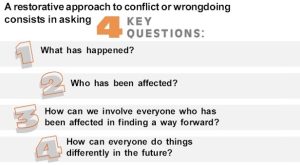Restorative Approach
Principles of the Restorative Approach in School
The aims of restorative approaches in our setting include:
- A safer, more caring environment. A more effective teaching and learning environment
- A greater commitment by everyone to taking the time to listen to one another
- A reduction in bullying and other interpersonal conflicts
- A greater awareness of the importance of connectedness to young people. The need to belong and feel valued by peers and significant adults
- Greater emphasis on responses to inappropriate behaviour that seek to reconnect, and not further disconnect, young people
- Reductions in fixed term exclusions and detentions
- A greater confidence in the staff team to deal with challenging situations
- An increased belief in the ability of young people to take responsibility for their choices, and more people giving them opportunities to do so
The restorative approach can provide the adult or child adversely affected by another person’s behaviour:
- An opportunity to explain the impact of the incident or behaviour
- An acknowledgement of the harm caused
- A chance to ask questions.
- Some control and choice
- Peace of mind about the future
- Apology/reparation/recompense
The restorative approach can give the adult or child who has done the harm:
- The opportunity to explain what happened.
- The opportunity to try to put right any harm caused.
- Some self-esteem recovery, when deeply ashamed eg with attachment disordered children
- Re-integration into the community.
The restorative approach is based on the belief that the people best placed to resolve a conflict or a problem are the people directly involved, and that imposed solutions are less effective, less educative and possibly less likely to be honoured. In order to engage in a restorative approach to conflict and challenging behaviour people need certain attitudes and skills. Skills-based training can develop both restorative skills and attitudes.
It can help participants to identify a variety of applications of these skills to meet the needs of the whole school community. The ultimate aim of the training and the project is to build a strong, mutually respectful, safe and inclusive school community in which everyone feels valued and heard.

